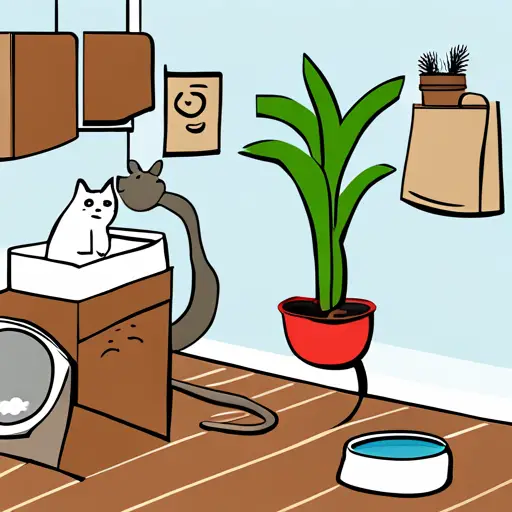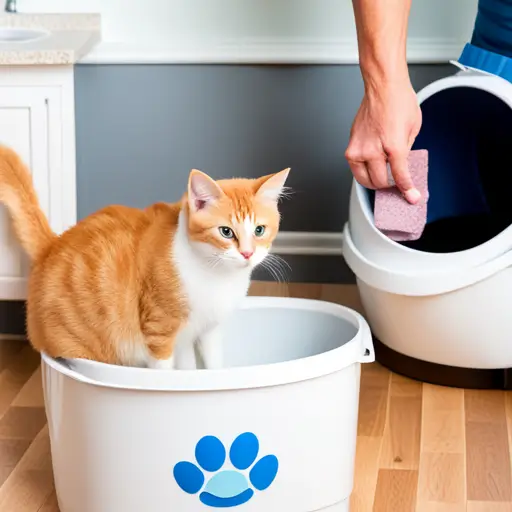Do you constantly clean up after your cat because they refuse to use the litter box? It can be frustrating and unsanitary, but don’t worry, there are steps you can take to help your furry friend get back on track.
First, it’s important to understand why your cat may be avoiding the litter box. Medical issues can be a common cause for litter box avoidance, so it’s important to rule out any potential health concerns with a visit to the vet. However, it’s also possible that your cat may be experiencing behavioral issues, such as stress or anxiety, which can also lead to litter box problems.
By taking the time to understand the root cause of the issue, you can take the necessary steps to help your cat get back to using the litter box as it should.
Key Takeaways
- Consult a vet to rule out any underlying medical issues causing litter box avoidance.
- Provide a clean and quiet environment with multiple litter boxes and experiment with different types of litter.
- Use positive reinforcement and training techniques to encourage correct litter box use.
- Provide environmental enrichment to reduce stress and anxiety and promote good litter box habits for your cat’s health and happiness.
Understand the Possible Reasons for Litter Box Avoidance

If your cat’s avoiding the litter box, it’s important to understand the reasons why. It could be due to a medical condition, such as a urinary tract infection, which makes it painful for your cat to use the litter box. Consulting a vet is crucial to rule out any underlying health issues that may be causing your cat’s litter box avoidance.
Additionally, environmental factors may also be the cause. Cats are creatures of habit and may be stressed by changes in their environment, such as the introduction of a new pet or a move to a new home.
When it comes to environmental factors, it’s important to evaluate any changes in your cat’s routine or surroundings. Have you recently changed the type of litter or litter box? Is the litter box in a location that’s difficult for your cat to access or in a noisy area? These factors can all contribute to your cat’s litter box avoidance.
By taking a closer look at your cat’s routine and environment, you can identify the possible causes and take the necessary steps to address them.
Address Medical Issues

First, you need to take your feline friend to the vet to rule out any medical problems that may be causing them to avoid the litter box. Cats can develop urinary tract infections, bladder stones, and other illnesses that make it painful for them to use the litter box. If your cat is experiencing pain, they’ll associate the litter box with discomfort and start avoiding it.
Consult a vet to get a proper diagnosis and treatment plan. Aside from seeking medical attention, you can also provide a clean environment and monitor your cat’s litter box habits. Make sure to scoop the litter box daily and replace the litter every two to four weeks.
If you have more than one cat, provide multiple litter boxes in different areas of your home. Keep the litter box away from high-traffic areas and loud noises as cats prefer a quiet and private place to do their business. By addressing medical issues and providing a clean and comfortable environment, you can help your cat feel more comfortable using the litter box again.
Tackle Behavioral Problems

To address behavioral issues with a feline friend, it’s important to observe their daily routine and identify any potential stressors that may be causing them to avoid using the litter box. Training techniques can be helpful in retraining your cat to use the litter box. Positive reinforcement, such as treats and praise, can be used to encourage your cat to use the litter box.
In addition, environmental enrichment can be beneficial in reducing stress and anxiety in your cat. Providing toys, scratching posts, and comfortable resting areas can help alleviate boredom and stress. It’s also important to keep the litter box clean and in a quiet location to provide a comfortable and inviting space for your cat to use.
By addressing possible behavioral issues and providing a comfortable environment, you can help encourage your cat to use the litter box consistently.
Experiment with Litter Types

You might want to try out different types of litter to see if your feline friend prefers a certain texture or scent. This can be a bit of trial and error, but it’s worth it to find a litter that your cat will actually use. Some cats prefer a finer texture, while others prefer a coarser texture. You can try out litters made from clay, recycled paper, or even corn.
When considering scented options, be careful not to choose a litter that is too strong or overwhelming for your cat’s sensitive nose. Some cats may prefer unscented litter, while others may enjoy a light scent. To help you compare different types of litter, here’s a table to give you an idea of some common options:
| Litter Type | Texture | Scent |
|---|---|---|
| Clay | Fine | Unscented or Scented |
| Recycled Paper | Coarse | Unscented |
| Corn | Coarse | Unscented or Scented |
By experimenting with different litter types and textures, you may be able to find a solution to your cat’s litter box refusal. Remember to clean the litter box regularly and provide plenty of fresh water to ensure your cat’s health and happiness.
Reinforce Positive Litter Box Behaviors

It’s important to consistently praise and reward your furry companion when they use their litter box correctly. Positive reinforcement techniques can help your cat understand that using the litter box is a desirable behavior.
You can reward your cat with treats, verbal praise, or even a special toy after they use the litter box. This will encourage them to continue using the litter box in the future.
Another important factor to consider is litter box placement. Cats prefer a quiet and private space to do their business, so ensure that the litter box is placed in a quiet area away from heavy foot traffic.
Additionally, make sure there is more than one litter box available for your cat. This will reduce the chances of your cat refusing to use the litter box due to it being dirty or occupied by another cat.
By following these tips and using positive reinforcement techniques, you can help your cat develop good litter box habits and avoid any future accidents.
Conclusion
So, you’ve tried everything to get your cat to use the litter box but they still refuse? Don’t lose hope!
It’s important to understand the reasons behind this behavior and address any underlying medical or behavioral issues. Once you’ve ruled those out, you can experiment with different types of litter and reinforce positive litter box behaviors.
Cats are creatures of habit, and it may take some time and patience to get them back on track. Consistency and positive reinforcement are key.
Don’t punish your cat for accidents outside the litter box, as this can make the problem worse. Instead, reward them when they use the litter box appropriately.
With some persistence and effort, you can help your cat get back to using the litter box and living a happy, healthy life.
